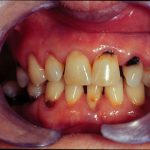 Tooth decay, commonly called cavities.
Tooth decay, commonly called cavities.
Dental decay caused by attack on the tooth enamel by acids produced by bacteria that are normally present in the mouth.
In dentistry, dental caries or cavities.
The medical term for tooth decay, commonly called cavities.
Breakdown and death of tooth tissue, resulting in soft, discolored areas. Studies suggest that eating sugary foods tends to produce tooth decay, as does failure to brush the teeth and remove food particles whereas fluoridation (e.g., in water, toothpaste) tends to prevent it. Also called dental caries.
Areas of destruction of bone or dental enamel.
Decay and crumbling of the substance of a tooth (dental caries) or a bone. The complete cause of dental caries has not yet been definitely established. It is particularly rife in children and young adults (the incidence reduces markedly after about 30 years of age) and most commonly affects people of Anglo-Saxon origin. A diet high in sugar and poor oral hygiene are other contributory factors. Caries appears to be induced by the action of Streptococcus bacteria on carbohydrates, mainly from the diet, which are attached to the tooth by means of a thin scum (pellicle) derived from the saliva. This entity, consisting of pellicle, bacteria, and carbohydrates, is plaque. Acid formed by the breakdown of carbohydrate by the bacteria gradually etches and decomposes the enamel of the tooth. If left unrepaired it progressively destroys the tooth completely, first exposing the deeper dentine, causing toothache, and eventually opening the pulp to allow ingress of infection into the bone and abscess formation. Repair consists of removing the decayed part of the tooth using a drill and replacing it with a filling.
Gradual decay and disintegration of soft or bony tissue or of a tooth. If the decay progresses, the surrounding tissue becomes inflamed and an abscess forms (e.g., chronic abscess, tuberculosis, and bacterial invasion of teeth). In caries, the bone disintegrates by pieces, whereas in necrosis, large masses of bone are involved.
